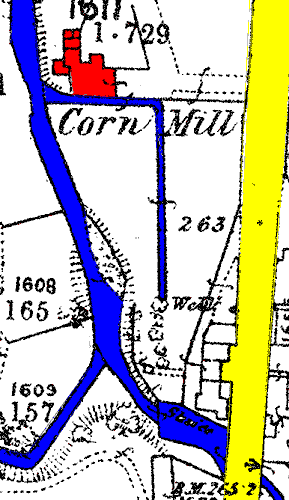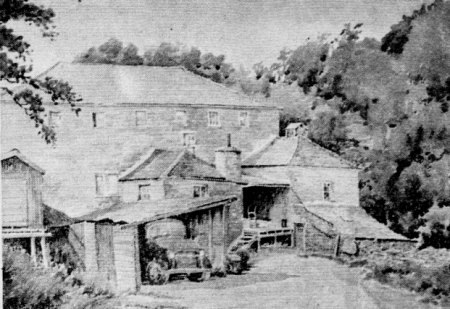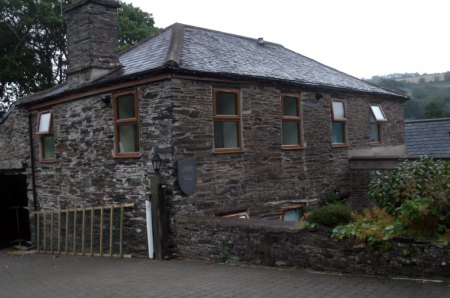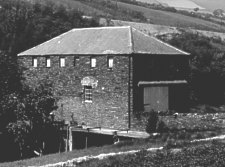(49) Lower Foxdale Mill

From 1868 O/S Plan IX/15 - SC 276795
The St John's to Castletown road runs N-S; the plan
predates the now removed St
John's to Foxdale railway which ran to the west of the Foxdale River
which runs S-N joining the Neb around St John's. The waterfall from
which Foxdale derives its name, is just off the map to the west .
|

From an illustration and article in Mona's Herald 26 January
1960
Many, many, hard working hours have, and still do, go
on in this old Mill. But I wonder how many people in the Island have
ever seen it, as depicted in the water colour reproduced above ? (Asks
Alec C. Quayle. ) Every year thousands of people pass within a stone's
throw of Lower Foxdale Mill, situated on the river side of Lower Foxdale
Post Office and Stores, on the main Peel to Castletown Road. Snug in
a hollow below road level, Keig's Mill is a busy spot, and just the
place to give an artist complete satisfaction. Although there has not
been a date stone found, Mr. Joe Keig, who at present works the Mill,
told me his father, William Keig, who came from Kewaigue Mill, said
it was over 100 years old. Built of grey stone, the main building holding
the milling plant and storeage is of four floors, and under the neat
ventilator on the little building on the right is the kiln where grain
is dried. The most important room - in the centre of the picture - complete
with chimney, is the office. ...At the rear of the building the large
water-wheel operated up to twelve months ago, but now it is powered
by electric and diesel. Hidden below the colourful foliage on the steep
bank flows the Foxdale River, to join the Neb lower down.
|
There would appear to be no earlier mentions of a Mill on this spot and the
first mention I can find of this mill is in an advertisment for a Coroner's
sale in Manx Sun, 20th April 1872:
CORONER'S SALE. TO be SOLD by PUBLIC AUCTION, under due process of law, on
WEDNESDAY the 8th May next and following days, the real and personal ESTATE
and EFFECTS of Mr John Johnson, junior, of FOXDALE MILLS, in the Parish of
Patrick. The real estate at Lower Foxdale, comprises newly erected water,
flour, and threshing Mills, Kiln, Store-house, Stable aud Piggeries; that
well accustomed and convenient store and provision Shop: that commodious Dwelling
House, Yard Garden, and Premises in the occupation of the proprietor; ...
In a later article Mona's Herald, 17th December 1873 dealing with a
claim for possession of some sacks of flour sold by the Coroner we learn:
Henry Kaye, late coroner of Glenfaba Sheading, said: John Johnson first became
bankrupt on the 2nd of March, 1872, under an execution obtained by William
Moore for £365 1s 1d. Previous to this I held executions against Johnson.
I held one as early as January, 1872. He failed to pay that execution, but
he arranged with Mr Kelly to pay it. There was a sale called under that judgment,
and the intervention of Mr Kelly saved the sale. On the 28th March, 1872,
an arrest for land rent against Johnson was put into my hands, and on the
11th April I appraised on Johnson's goods. By Mr Callow : I did not take proceedings
under Moore's execution until the 2nd of March, and Johnson went on with his
business until that time.
James Killey sold, for £37 2s 6d, a parcel of Ballabenna, known as the
Garey to John Johnson, jnr (grocer, Kk Patrick) by deed dated 28th November
1864 - the land was stated to be 1ac 1r 27p in extent, situate on the west side
of the main road from St Johns to Castletown, bounded on the north by land sold
for the site of a Primitive Methodist Chapel, on the east by the road leading
to Ballabenna farmhouse and on the south by part of Ballabenna. It would thus
appear that the mill was erected a short time before the 1868 plan was surveyed.
The cost of building and equiping it must have been considerable.
John Johnson jnr would appear to be the son of John Johnson who is noted as
of Whitehaven and who came over to the Island some time in the 1830s, noted
as lead ore miner in 1841, in 1851 as master of a number of lead ore washers
and by 1881 he was a farmer in Ballamore, also noted as a trustee of Glen Maye
Primitive Methodist Chapel from 1841 onwards. John jnr was son by Anne Quirk
his first wife but there was an extensive family by Margaret Cowley his 2nd
wife. In December 1870 John Johnson jnr, now described as miller with wife Sarah
borrowed £600 at 5% interest, from Wm Moore, corn merchant Liverpool,
giving as security the land and mill - the deed being cancelled by full repayment
to Wm Moore on 22nd Feb 1873; he also bought, in February 1871 for £250,
at a Coroner's auction the adjacent shop fronting the main road, borrowing £150
from two corn merchants using it as security - again this debt was paid off
in February 1873. John, wife and family would appear to have left the Island
about this time as in 1881 he is noted as a book-keeper at a sawmill in Kirkdale.
The Mill would appear to have remained in the family, possibly the father
paying off the debts, as in 1900 the then owner, William George Johnson son
of John Johnson,snr, by his second wife was also declared bankrupt - his public
examination as reported in Isle of Man Times, 1st December 1900 make
interesting reading
In the matter of the estate of William George Johnson, of Foxdale. miller,
proof of claims and the public examination of the bankrupt, were down for
the Court at Peel on Monday. There were no claims proved. The bankrupt was
in attendance for his public examination, and, questioned by Mr Clucas, said:
I have lived all my life at Ballamoar, Foxdale. I lived with my father until
his death, in April, 1895. In 1898[sic] I was engaged in my father's business
as a miller, and I carried that on after his death. Under my father's will
I became entitled to his real estate. It was heavily mortgaged - altogether
for £2719. The property consisted of a farm, a mill, five dwelling-houses,
and a shop. I estimated the value of the property at £3270. My father
also charged the property with an annuity of £26 a year to my mother
during her life. The total rental, excluding the mill and the house, which
I occupy myself, is about £80 a year. I attribute the cause of my failure
to the fact that, in addition to the interest on the mortgages, which took
up almost the whole of the rents, I had to pay this £26 a year. There
was also a good deal necessary for repairs, and a £10 legacy left by
my father. The business of a miller I carried on at a profit, but the other
matter was killing it. I turned over about £130 or £140 a year
in the mill. I employed a miller at 9s a week and his keep, and when I was
from home there was another man employed. Coke, oil, &c, would run to
about £20 a year. It was principally during the winter that the mill
was worked.
The Deemster: Excluding the interest on the mortgages, what did you clear
on the mill ? - I do not know that I was making a profit. Further questioned
by his Honour, Johnson said that, alter paying rents and expenses, he would
have about £1 a week as working wages for himself.
The trustee was of opinion that the real estate would not fetch sufficient
to cover the mortgages, and his Honour remarked that was very probable considering
there was so much property on the market.
After reading over the depositions to the debtor, his Honour further questioned
him as to whether he was making a profit on the mill - Johnson replied he
had no accounts that would show accurately, and his Honour remarked as to
the foolishness of men carrying on business without keeping accounts. They
might be carrying on when it was not worth while. Debtor replied that that
was the conclusion he had come to - His Honour: You should have ascertained
the state of your affairs from week to week, and month to month, and have
found out whether it would not have been better to give it up, and go to America
or some other country.
The Peel City Guardian, 22nd December 22, 1900 reported
W.G. JOHNSON BANKRUPT.
At the Ramsey Court on Monday, before Deemster Moore, Mr G. F. Clucas presented
the petition of William Kermode, trustee in bankruptcy of William George Johnson,
Foxdale, asking for the approval of the Court to the sale of the property
of the Bankrupt to Thomas James Southward, for the sum at £3,000. William
Kermode deposed that he put the property up for auction, but it didn't fetch
a bid. There was an annuity chargeable on the property of £26 a year.
The offer made by Thomas James Southward (Sulby) of £3,000 was a good
one, and it would be advisable to accept it. His Honour approved of the sale
at the sum stated.
The Southwards tried to sell it - the Isle of Man Times, 6th September
1902 carries the notice:
MESSRS CHRYSTAL BROTHERS have received instructions from Messrs Southward
Bros., to SELL by AUCTION, on WEDNESDAY, the 17th instant, those excellent
and well-known THRESHING and CORN MILLS known as "FOXDALE MILLS."
Also a compact DWELLING HOUSE with Garden , and small FIELD of good arable
and pasture land thereto adjoining. Possession on the 12th day of November,
1902. The Properties may be offered in one or more lots. Auction on the premises
at 3 p.m., when conditions will be declared. In the. meantime apply to the
owners, Sulby Glen, Lezayre; or the Auctioneers, Ramsey.
It would not appear to have sold as Southwards were still offering it to let
in 1905 - W G Johnson was also still working as a miller until late 1905 as
in giving evidence at the inquest of an old lady who had died after he collided
with her whilst cycling back from Douglas, he stated he was a married man, a
miller but not worked since Hollantide.
The next miller associated with the Mill appears to be William Arthur Crellin,
who avoided conscription in 1916 as milling was an exempt occupation though
it would appear he too had difficulty making the mill pay as in 1937 he was
summoned for not paying his rates.
The next miller to appear in the press was in 1947 when Joseph Keig, mentioned
in the 1960 article above, was fined 10/- and costs for driving an unlicensed
car. In the 1950's regular advertisements for the Mill and its associated shop
appeared in the press - typical was Isle of Man Examiner, 8th July 1955:
NOTICE to FARMERS - Have your Grain dried and milled by experienced men and
up to date machinery at Lower Foxdale Mills. Fine grinding for young speciality.
Our lorries collect and deliver daily, -Joseph Keig. Peel 465 and 558.
The Mill is no longer active and would appear to have been turned into domestic
dwellings - the photograph shows to top 2 floors of the mill, a road now running
between it and the river - named as Upper Mill on what would have been the side
wall above the water wheel.
 |

pre WW2 photo showing feed to wheel |




